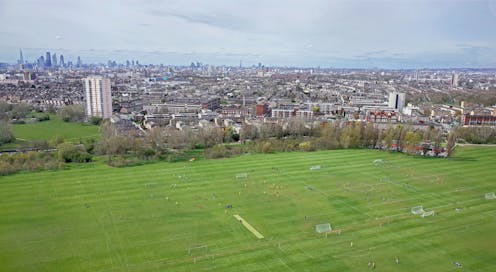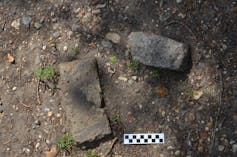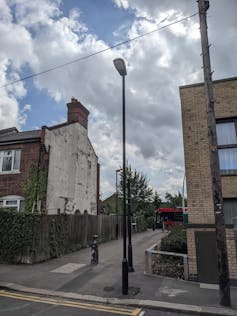
During the second world war, German forces dropped 28,000 bombs and almost 3,000 V1 flying bombs and V2 rockets on London. Nearly 30,000 people were killed. The damage to the built environment was extensive.
Within the London County Council area (roughly covering today’s inner London), more than 73,000 structures were totally destroyed. Local surveyors, construction workers, architects and engineers documented the destruction as it happened on hand-coloured maps, which are now held at the London Metropolitan Archives. Some 43,400 structures recorded on these maps were categorised as “damaged beyond repair”.
City authorities were faced with the gargantuan task of figuring out quite where to put the millions of tonnes of rubble. My recent study looks at the largest of these rubble dumps – at Hackney and Leyton Marshes in east London – and the remarkable afterlife it has had, as the wellspring of English grassroots football.
When rubble choked the city of London
Between December 1940 and 1946, 2.2 million cubic metres of concrete, brick and stone rubble were dumped on Hackney Marsh and 270,000 cubic metres on Leyton Marsh, raising the ground level by three metres. If piled together, the volume would have exceeded the Great Pyramid.
In 2021 and 2022, I conducted an archaeological walkover and photographic surveys of the marshes. I struggled to find obvious evidence of the conflict. The rubble lies hidden under plants and soil with only occasional surface fragments of concrete and the odd brick hinting at the site’s wartime origins.

Comparing images from surveys by aerial lidar (a laser-light technology used for 3D mapping) with historic maps shows how both sites are now marshes in name only. The elevation created by the rubble is visible both in sharp breaks of slope on the maps and, on the ground, in the unexpectedly steep staircases you have to climb in order to reach the football pitches from the bank of the River Lea.
Venture to neighbouring Leyton and Clapton and where the rubble came from becomes far more visible. Street after street showcase gaps where houses are missing in otherwise neat terraces. Modernist blocks abut awkwardly against Victorian townhouses.

The first weeks of the Blitz, in September 1940, saw London’s 29 borough councils increasingly unable to cope with a backlog of 2.7 million tonnes of rubble. It effectively choked the city, blocking miles of roads and rendering vital services inoperable.
By the end of September, the city-wide War Debris Survey and Disposal Service was established. Early dump locations it selected included disused gravel pits on Hampstead Heath and the site of the 1851 Great Exhibition in Hyde Park, which had been quarried for sand to fill sandbags in the first years of the war.
As the bombing intensified, larger spaces were soon needed. The service turned its sights eastwards, to the wide-open marshland of east London.
The infilling was primarily undertaken to clear London’s bombed streets. It also had a more constructive purpose. A 1942 memo written by the Ministry of Home Security (now held in the London Metropolitan Archives) notes:
Sites for tips should be studied and selected. The opportunity may be taken to make up to new levels land which is subject to flooding or to improve other waste and uneven sites.
How Hackney Marshes became a footballing utopia
At the east London site, 250,000 cubic metres of soil from upriver reservoir construction was added to the rubble. This was then seeded to create 135 football pitches, as well as numerous cricket pitches and changing rooms.
This transformation represented a remarkable turnaround for the jumbled debris of a violent conflict and was noted as such, during the war itself. In 1942, the leader of the London County Council, Lord Latham, remarked that “the battle of London has helped to win a new playing field for future generations of Londoners”.
Though unmarked by commemorative plaques, the pitches themselves have become a vast footballing heritage site, the “utopia,” as founder of Hackney Wick Football Club Bobby Kasanga has put it, “of grassroots football”.
In 1953, seven years after the pitches opened, a British Pathé newsreel reported a “six to ten month” wait for a booking: “A team lucky enough to get a dressing room shares it with their opponents – typical, this, of the sporting spirit of these Londoners.”
The popularity of the site stemmed from it not only being the largest agglomeration of football pitches in the world, but also from its accessibility. It was a place where locals and recent immigrants to London alike could share their love for the beautiful game.
The Hackney and Leyton Football League, founded when the pitches opened in 1946, remains London’s largest and oldest league. It has cemented the reputation of the site, with legendary England players, including Bobby Moore and David Beckham, having trained there.
In 1997, Ian Wright featured along with Eric Cantona, Robbie Fowler and David Seaman, in a Nike ad soundtracked by Blur’s smash hit Parklife and shot on the marshes. Adidas, meanwhile, flew Lionel Messi on to the pitches by helicopter for a promo match, in 2010, only to have to drive him away by van when he was mobbed by fans.
As more rugby and cricket pitches have been added, the number of pitches has reduced down from the original 135 to 70. Hundreds of players from diverse, working-class communities across London still flock there each weekend though.
UK photographer Simon Di Principe used to go to the marshes as a kid, with his mother, to watch his father play. His 2016 book, Grass Roots, documents a full season of these amateur Sunday league games, in what Di Principe has said is “a contemporary testament and celebration of what makes London a multicultural city”.
The marshes endure as a subtle reminder of the losses the people of London incurred during the second world war.
The successive grassroots campaigns that have thwarted a variety of proposed developments in recent years are a testament to the value the site continues to hold, for those future generations of post-war Londoners that Latham foresaw.
Jonathan Gardner does not work for, consult, own shares in or receive funding from any company or organisation that would benefit from this article, and has disclosed no relevant affiliations beyond their academic appointment.
This article was originally published on The Conversation. Read the original article.







